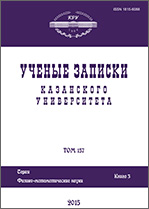|
|
Kazanskii Gosudarstvennyi Universitet. Uchenye Zapiski. Seriya Fiziko-Matematichaskie Nauki, 2006, Volume 148, Book 1, Pages 83–89
(Mi uzku525)
|
 |
|
 |
The XI International Youth Scientific School "The Coherent Optics and Optical Spectroscopy"
Formation dynamics of the radial-angular structure of the Rydberg wave-packet in a resonant microwave field.
P. A. Volkov, M. A. Efremov, M. V. Fedorov
General Physics Institute named after A. M. Prokhorov, Russian Academy of Sciences
Abstract:
We discuss a very interesting experiment by H. Maeda, T. F. Gallagher, PRL 92, 133004 (2004), in which Li Rydberg atoms were exposed to an action of a resonant microwave filed (switched-on at $t=0$). Then, in a varying time $t_0$, the atoms were ionized by a strong sub-picosecond Half-Cycle Pulse. The probability of ionization $w_i$ was measured in its dependence on $t_0$ and the function $w_i(t_0)$ was found to be oscillating with the classical Rydberg-atom Kepler period. The original author's explanation of this effect was based on the assumption that the resonant microwave field provided formation of a localized Rydberg wave packet moving along the classical Kepler trajectory and responsible for the observed periodical dependence of $w_i(t_0)$. We suggest here an alternative interpretation of this result. By solving exactly the initial-value problem for a Rydberg atom in a microwave field we find that such a field does not provide any radial localization of a wave packet. On the other hand, it provides a rather efficient repopulation of the resonant Rydberg levels with high values of the angular momentum quantum number $l$. Migration of population to high-$l$ states is shown to cause a modulation of both angular and radial motion of a Rydberg electron. Such a periodical modulation of the electron motion is believed to provide a proper explanation of the experimental results by Maeda and Gallagher.
Received: 03.02.2006
Citation:
P. A. Volkov, M. A. Efremov, M. V. Fedorov, “Formation dynamics of the radial-angular structure of the Rydberg wave-packet in a resonant microwave field.”, Kazan. Gos. Univ. Uchen. Zap. Ser. Fiz.-Mat. Nauki, 148, no. 1, Kazan University, Kazan, 2006, 83–89
Linking options:
https://www.mathnet.ru/eng/uzku525 https://www.mathnet.ru/eng/uzku/v148/i1/p83
|

| Statistics & downloads: |
| Abstract page: | 184 | | Full-text PDF : | 58 | | References: | 33 |
|




 Contact us:
Contact us: Terms of Use
Terms of Use
 Registration to the website
Registration to the website Logotypes
Logotypes








 Citation in format
Citation in format 